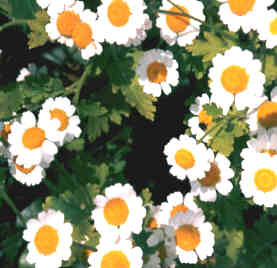
Plant Description
Caution & Interaction

Latin (botanical) name:
Tanacetum parthenium
Common names: Featherfew, Featherfoil, Midsummer Daisy, Bachelor’s Buttons, Altamisa, Nosebleed, Flirtwort
Plant Description: Feverfew is native to southwest Europe and was originally brought to America as an ornamental plant. It is commercially cultivated in Japan, Africa and Europe. It is a hearty perennial that will produce numerous, small, daisy-like heads of yellow flowers with outer white rays, the central yellow florets being arranged on a nearly flat receptacle. It grows up to 2-3 feet and has a downy, finely furrowed, erect stem. The yellowish-green leaves alternate, and are downy with short hairs or nearly smooth. They are about 4-1/2" long and 2" wide and have serrate margins. The Feverfew plant has a bitter taste and the odour is strongly bitter as well.
Medicinal Properties &Uses: Due to the anti-inflammatory properties of Feverfew, it is commonly and widely used to alleviate headache pain, both regular and migraines. It's constituents are comprised of sesquiterpene lactones (including parthenolide and santamarine), volatile oil, sesquiterpenes (including camphor, farnesene and germacrene), tannins, and monoterpenes. Of this range of compounds, over 85% are a compound called parthenolide. This compound in Feverfew reduces inflammation throughout the body, inhibits platelet aggregation which thins the blood, and inhibits release of serotonin and some inflammatory mediators. It works best if taken at the initial onset of a headache. Feverfew has also been used in the treatment of dysmenorrhoea and sluggish menstrual flow, and an infusion may be taken to cleanse the uterus after childbirth. It may also help ease the pain of arthritic and inflamed joints as well. Feverfew cools the body and is effective in reducing a fever. Because of its anti-inflammatory properties, it has been successfully used externally as an insect repellent and for treating insect bites.
Dosage: 20-40 drops in water or juice, 2-3 times daily, or as needed. Shake well before using.
Cautions & Interactions: Do not take during pregnancy. Keep out of reach of children.
Efficacy Studies & Other Clinical Data: Helpful Links:
Disclaimer (U.S. Only): These statements have not been evaluated by the FDA. These products are not intended to diagnose, cure, treat, or prevent any disease.
Common names: Featherfew, Featherfoil, Midsummer Daisy, Bachelor’s Buttons, Altamisa, Nosebleed, Flirtwort
Plant Description: Feverfew is native to southwest Europe and was originally brought to America as an ornamental plant. It is commercially cultivated in Japan, Africa and Europe. It is a hearty perennial that will produce numerous, small, daisy-like heads of yellow flowers with outer white rays, the central yellow florets being arranged on a nearly flat receptacle. It grows up to 2-3 feet and has a downy, finely furrowed, erect stem. The yellowish-green leaves alternate, and are downy with short hairs or nearly smooth. They are about 4-1/2" long and 2" wide and have serrate margins. The Feverfew plant has a bitter taste and the odour is strongly bitter as well.
Medicinal Properties &Uses: Due to the anti-inflammatory properties of Feverfew, it is commonly and widely used to alleviate headache pain, both regular and migraines. It's constituents are comprised of sesquiterpene lactones (including parthenolide and santamarine), volatile oil, sesquiterpenes (including camphor, farnesene and germacrene), tannins, and monoterpenes. Of this range of compounds, over 85% are a compound called parthenolide. This compound in Feverfew reduces inflammation throughout the body, inhibits platelet aggregation which thins the blood, and inhibits release of serotonin and some inflammatory mediators. It works best if taken at the initial onset of a headache. Feverfew has also been used in the treatment of dysmenorrhoea and sluggish menstrual flow, and an infusion may be taken to cleanse the uterus after childbirth. It may also help ease the pain of arthritic and inflamed joints as well. Feverfew cools the body and is effective in reducing a fever. Because of its anti-inflammatory properties, it has been successfully used externally as an insect repellent and for treating insect bites.
Dosage: 20-40 drops in water or juice, 2-3 times daily, or as needed. Shake well before using.
Cautions & Interactions: Do not take during pregnancy. Keep out of reach of children.
Efficacy Studies & Other Clinical Data: Helpful Links:
Disclaimer (U.S. Only): These statements have not been evaluated by the FDA. These products are not intended to diagnose, cure, treat, or prevent any disease.